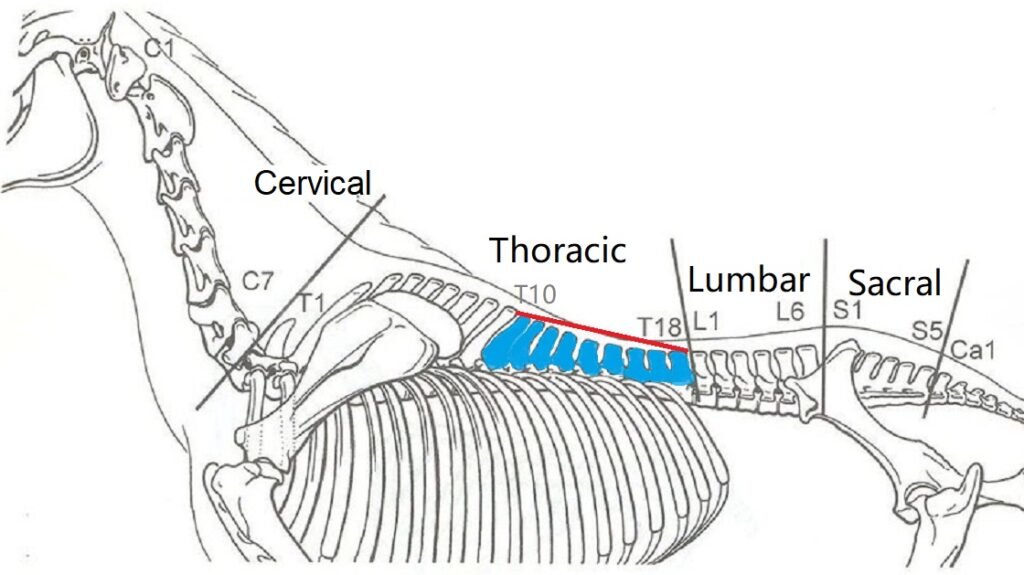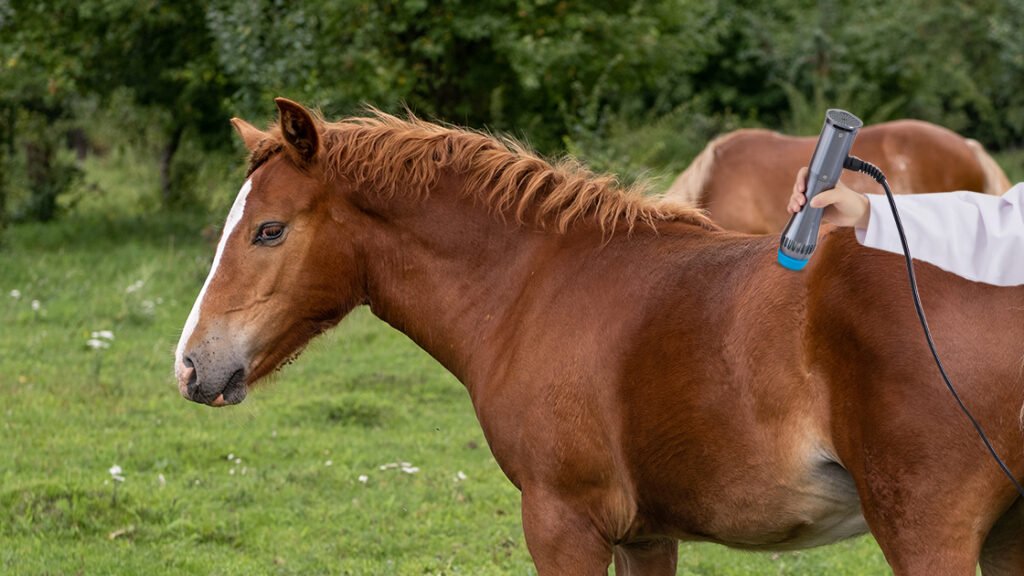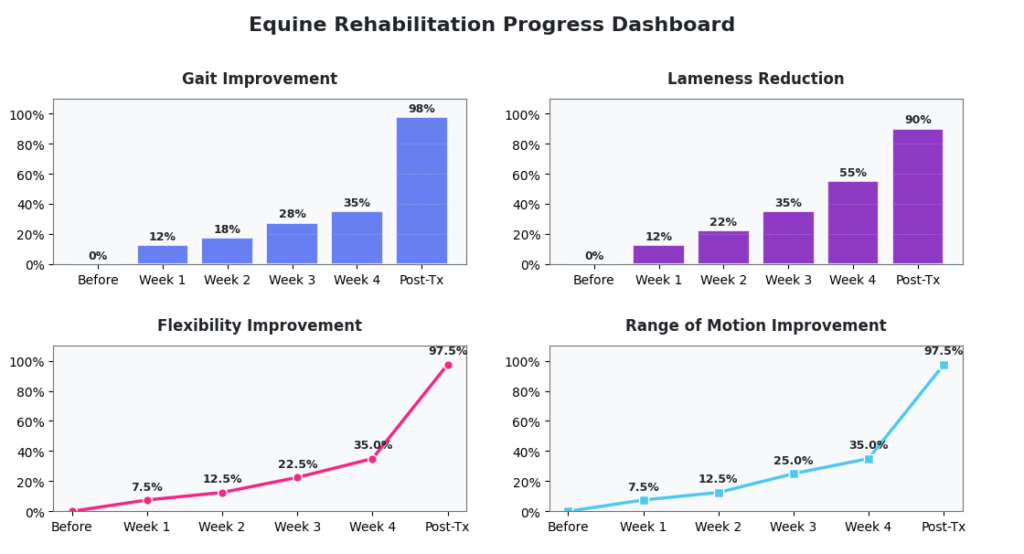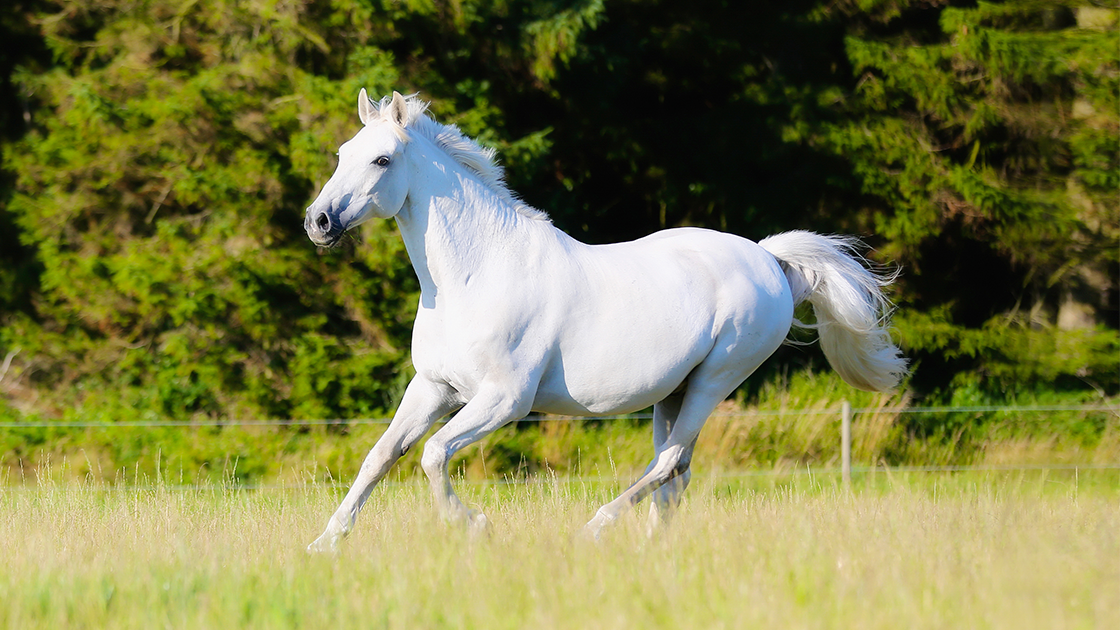Introduction: What Is Kissing Spine in Horses?
Definition of Equine Kissing Spine (Overriding Dorsal Spinous Processes)
Equine Kissing Spine, medically known as Overriding Dorsal Spinous Processes (ORDSP), is a painful spinal condition in horses. It occurs when the spinous processes—the bony protrusions extending from each vertebra—are positioned too closely together and begin to touch or even overlap. This close proximity leads to friction, inflammation, and ultimately, pain and reduced mobility. In severe cases, bony remodeling or bone-on-bone contact can be observed through radiographic imaging. The disorder is typically localized in the thoracic region (T10–T18) of the spine, although lumbar involvement is also possible.

Prevalence in Performance Horses
Kissing spine is particularly prevalent among performance horses, including show jumpers, dressage horses, and eventers. This is likely due to the physical demands placed on their backs through repetitive collection, jumping, or prolonged periods of flexion and extension. Veterinary studies suggest that up to 39% of horses subjected to diagnostic imaging for back pain show evidence of ORDSP. However, not all horses with radiographic signs will exhibit clinical symptoms. This discrepancy underscores the importance of a thorough physical examination alongside imaging diagnostics.
Common Symptoms and Behavior Changes
Horses suffering from kissing spine often display vague, inconsistent signs of discomfort. Common clinical symptoms include reluctance to be saddled, bucking under saddle, resistance to collection, back stiffness, lack of impulsion, hollowing of the back, head tossing, and behavioral changes such as pinning ears, tail swishing, or refusal to move forward. Because these signs can also be linked to other orthopedic or tack-related issues, a definitive diagnosis often requires a combination of palpation, flexion testing, ridden assessment, and diagnostic imaging such as X-rays or ultrasound.
Why Shockwave Therapy for Kissing Spine?
Overview of Shockwave Therapy in Equine Medicine
Extracorporeal shockwave therapy (ESWT) is a non-invasive treatment that delivers high-energy acoustic waves to target musculoskeletal issues. Initially developed for human lithotripsy, shockwave therapy has been adapted in veterinary medicine to manage tendon and ligament injuries, joint disorders, and back pain. In horses, ESWT has become an increasingly popular treatment for conditions like suspensory ligament desmitis, navicular syndrome, and, notably, kissing spine.
How It Works: Focused Acoustic Energy for Pain Relief
Shockwave therapy works by sending focused acoustic pulses into affected tissue. These shockwaves stimulate cellular responses that lead to increased blood flow, recruitment of healing factors, and modulation of inflammation. One key mechanism is the stimulation of mechanotransduction pathways—where cells convert mechanical stimuli into chemical activity. Additionally, ESWT promotes neovascularization (the formation of new blood vessels) and increases nitric oxide production, both of which enhance tissue regeneration and pain relief.
Backed by Studies and Veterinary Use Cases
Clinical evidence supports the use of shockwave therapy in treating back pain related to kissing spine. Multiple veterinary case reports and peer-reviewed studies document marked improvements in pain relief, behavior, and performance following ESWT. In one study, horses treated with shockwave therapy showed significant improvements in spinal flexibility and owner-reported comfort levels compared to those receiving conservative treatments alone. Veterinarians widely consider ESWT a safe, effective adjunct or alternative to surgery in many kissing spine cases.

Benefits of Shockwave Therapy for Equine Back Pain
Reduction in Inflammation
One of the primary benefits of shockwave therapy is its ability to reduce inflammation. ESWT inhibits pro-inflammatory mediators and encourages macrophage activity, which helps clear cellular debris and initiate the repair process. This results in decreased swelling and a notable reduction in pain at the treatment site.
Improved Circulation and Oxygenation of Back Muscles
Shockwave therapy enhances local blood circulation by promoting angiogenesis (formation of new blood vessels) and dilating existing vessels. Increased blood flow ensures that oxygen and essential nutrients reach affected muscles and soft tissue, which is crucial for cellular repair and overall recovery.
Natural Pain Relief for Equine Back Pain
ESWT stimulates the release of endogenous opioids and endorphins—natural pain-relieving compounds. This means that horses experience significant pain relief without reliance on non-steroidal anti-inflammatory drugs (NSAIDs) or corticosteroids, making shockwave therapy an excellent option for long-term management.
Accelerated Healing in Soft Tissue and Bone
Shockwave therapy has been shown to accelerate healing in both soft tissue and bone. It encourages osteogenesis (bone growth) and stimulates tenocyte and fibroblast activity, aiding in the regeneration of tendons, ligaments, and fascia. For kissing spine, this means improved resilience in surrounding supportive structures and reduced risk of reinjury.
Long-Term Improvement in Flexibility and Gait
Horses receiving regular ESWT sessions often display long-term improvements in spinal flexibility, stride length, and symmetry. These changes are particularly important for performance horses, as enhanced biomechanics translate to improved performance and reduced risk of compensation injuries elsewhere in the body.
Shockwave Treatment Plan for Kissing Spine
How Often Should Horses Receive Shockwave Therapy?
A standard treatment protocol typically involves 3–6 sessions of shockwave therapy, spaced 1 to 2 weeks apart. The exact frequency depends on the severity of the condition, response to initial sessions, and whether the horse is in active training. Some horses may benefit from monthly maintenance sessions, particularly if they are returning to a demanding performance schedule.
Targeted Areas: Thoracic and Lumbar Vertebrae
Veterinarians use diagnostic imaging and physical palpation to identify precise treatment zones, typically targeting the thoracic vertebrae (T10–T18), where most kissing spine lesions occur. In some cases, lumbar vertebrae are also treated, particularly if compensatory pain or tightness is identified in that region.
Combining with Other Modalities (Chiropractic, Rehabilitation Exercises)
Shockwave therapy yields the best outcomes when used in combination with other therapeutic approaches. Chiropractic adjustments can correct spinal misalignments that contribute to kissing spine. Additionally, structured rehabilitation exercises—such as core strengthening, long-lining, pole work, and hill work—help improve spinal stability and muscular balance. Saddle fit evaluations and physical therapy may also be integral components of the treatment plan.
What to Expect During and After Sessions
Shockwave sessions are usually conducted at the barn or clinic and last about 15–30 minutes. Horses may be lightly sedated to ensure stillness. A handheld probe delivers focused energy pulses to the targeted spinal region. Mild soreness may occur for 24–48 hours post-treatment, but most horses show noticeable relief shortly thereafter. Light work or turnout is often recommended during the initial treatment phase.
Monitoring Progress with Follow-Up Exams
Veterinarians monitor progress through physical exams, performance assessments, and sometimes follow-up imaging. Owner and rider feedback also play a vital role in evaluating treatment efficacy. Adjustments to the therapy plan are made based on the horse’s comfort level, workload, and observed behavioral changes.
Risks, Side Effects, and Contraindications
Mild Discomfort or Local Sensitivity
Shockwave therapy is generally well tolerated by horses. However, minor discomfort during or shortly after treatment can occur. This is typically due to the mechanical pressure exerted by the acoustic waves on the targeted tissues. Some horses may react by flinching or displaying muscle twitches during application. Local sensitivity can last up to 48 hours post-treatment, especially if the area already shows signs of inflammation. Mitigating this involves adjusting energy levels during the session and using sedation if necessary to keep the horse calm. Veterinarians may also apply a topical analgesic or administer anti-inflammatory medication depending on the horse’s individual pain threshold and history.
Rare Side Effects and How to Prevent Them
Although rare, potential side effects include:
- Localized swelling or hematoma from vascular disruption
- Tissue overheating, especially with overuse or incorrect probe calibration
- Unintended stimulation of adjacent nerves, which may cause temporary discomfort or behavior change
To prevent complications, it is crucial that only licensed veterinary professionals or certified equine therapists administer shockwave therapy. Equipment calibration, accurate anatomical targeting, and thorough clinical evaluation prior to treatment help ensure safety. Pre-treatment diagnostics (e.g., radiographs or ultrasound) are especially recommended when underlying conditions such as spinal fractures or neoplasia are suspected.
When Shockwave May Not Be Recommended

Shockwave therapy may not be appropriate in the following cases:
- Active bone infections (osteomyelitis)
- Neoplastic lesions near the spine
- Pregnant mares, as acoustic waves can pose a risk to fetal development
- Recent surgical wounds near the treatment site
In these cases, veterinarians may delay treatment or pursue alternative therapies such as low-level laser therapy or targeted physical rehabilitation. A full veterinary assessment should precede any decision to include or exclude shockwave therapy.
Owner and Trainer Insights: Real Results in the Field
Case Study: Competitive Jumper’s Return After Kissing Spine Diagnosis
A 10-year-old Warmblood gelding competing in show jumping developed a noticeable performance decline, accompanied by tail swishing, bucking under saddle, and stiffness during lateral work. Radiographs confirmed kissing spine between T14–T17. After three sessions of focused shockwave therapy at two-week intervals, combined with core-strengthening rehab and turnout, the gelding’s behavior dramatically improved. By the third month, he returned to light jumping and placed in the ribbons at a regional competition. Follow-up imaging showed a reduction in soft tissue inflammation, and his topline had visibly strengthened.

Trainer Testimonials: Performance Improvement Without Surgery
Trainers and barn managers frequently report that horses treated with shockwave therapy:
- Show increased willingness to work
- Have fewer resistance behaviors under saddle
- Exhibit smoother transitions and enhanced range of motion
Many emphasize that shockwave therapy allows them to avoid surgical intervention, which typically involves dorsal spinous process resection and a lengthy rehabilitation period.
Rehabilitation Timeline and Adjustments
A typical post-treatment rehab plan includes:
- Week 1–2: Limited turnout and hand-walking
- Week 3–4: Introduction of ground poles and long-line work
- Week 5–8: Progressive ridden work focusing on stretching and engagement
- Month 3–4: Return to full training and athletic performance
Therapy may be repeated quarterly or biannually depending on recurrence of symptoms or physical demands of the sport.
Investing in Your Horse’s Long-Term Soundness Today!
Kissing spine can be a daunting diagnosis, but it doesn’t have to end a horse’s athletic career. Shockwave therapy offers a scientifically backed, non-invasive approach to managing pain and restoring function. When integrated with thoughtful rehabilitation, routine veterinary check-ups, and proper saddle fit, it can dramatically enhance a horse’s comfort and longevity. Whether your goal is to return to the show ring or simply ensure your horse’s quality of life, shockwave therapy stands out as a modern, effective tool for equine spinal health. Consult your equine veterinarian today to determine if this modality fits your horse’s individual needs.
References
Kissing Spines | School of Veterinary Medicine. UC Davis.
https://ceh.vetmed.ucdavis.edu/health-topics/kissing-spines
Kissing Spine in Horses | PetMD.
https://www.petmd.com/horse/conditions/musculoskeletal/kissing-spine-horses
Shockwave Therapy in Horses: Uses, Benefits & Side Effects:
